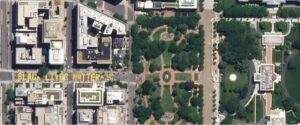NRO to award multiple imagery contracts by year’s end
By Debra Werner

By the end of the year, the National Reconnaissance Office plans to issue “multiple operational commercial imagery contracts to support defense, security and many other U.S. government missions,” said Pete Muend, director of NRO’s Commercial Systems Program Office. “We’re very excited to begin to leverage all the capabilities that our U.S. domestic commercial industry base can provide.”
NRO took over the job of acquiring commercial satellite imagery from the National Geospatial Intelligence Agency (NGA) in 2018. Since then NRO has surveyed the capabilities of the rapidly expanding commercial satellite industry.
“We’ve been conducting market research and engaging with the commercial imagery providers to determine the extent to which the U.S. commercial remote sensing industry can satisfy our requirements now, through 2025 and beyond,” Muend told SpaceNews. “We’re looking to buy where we can from commercial providers and, only where sources aren’t available, build systems to meet our unique tailored needs.”
As part of its market research, NRO awarded study contracts in 2019 to Earth observation companies BlackSky Global, HyspecIQ, Maxar Technologies and Planet. The contracts allowed NRO to compare each company’s current and planned capabilities with imagery requirements established by NGA.
“One of the big take-aways from those study contracts is that we’re not looking at a single provider to meet the entirety of our needs,” Muend said. “And we don’t see a future where we would look to a single provider.”
Instead, NRO envisions “leveraging the aggregate, the whole of industry in sum total, to meet our requirements,” Muend said. “We are looking toward a future where the vast majority of our requirements can be satisfied in aggregate by multiple providers, especially over time as they build up their capabilities.”
In addition to surveying the commercial imagery market, NRO is refining processes for tasking satellites and ingesting data.
NRO awarded study contracts late last year to Capella Space, a radar satellite startup, and HawkEye 360, a firm that operates a cluster of three satellites to identify and geolocate radio-frequency signals. By working with Capella and HawkEye 360, NRO is “making sure that our architecture and our interfaces are able to deal with those sorts of data,” Muend said. “When we have better articulated needs across that class of phenomenologies, our architecture will be poised to ingest and work with those sorts of data.”
That will require “some modifications to our architecture and that progress is well underway,” Muend said. “In fact, we’re beginning to see the initial instantiations of that architecture. Obviously, we’re working very closely with NGA and the rest of the user community to make sure it’s successful.”
NRO intends to complete the architecture modifications “at least to a reasonable extent” by the time the agency awards operational imagery contracts later this year, he added.
In spite of NRO’s prodigious demand for imagery, the agency is not asking commercial imagery providers to cater exclusively to the U.S. government.
“We want to be the one of a number of customers for them,” Muend said. “It’s through that approach that we leverage the capital efficiencies of engaging in the commercial marketplace.”
For operational imagery contracts, NRO is looking for ways to simplify End User License Agreements, which specify how imagery can be shared. For instance, is a particular data set limited to the intelligence community and the Defense Department, or can it be shared with state and local governments, foreign mission partners and nongovernmental organizations.
“One of the things that we recognized is that the licenses under which we buy the imagery are very important,” Muend said.
Licenses negotiated individually with commercial imagery providers, can include “multiple pages of legalese,” Muend said. “That would make it hard, for example, for warfighters in tactical situations to decide whether or not a given image can be shared with a mission partner.”
To simplify the decision, NRO is considering establishing “a family of End User License Agreements” with different rules for imagery dissemination, Muend said.
NRO plans to issue a Request for Information seeking industry feedback on the idea of creating standard license agreements.
“As you might imagine, asking a computer to parse and make decisions based on pages of individually negotiated legalese might be difficult,” Muend said. “With more standardized End User License Agreements, we can program computers to make decisions in terms of where imagery can flow and where it is precluded from flowing, as opposed to asking a lawyer every time.”
This article originally appeared in the June 15, 2020 issue of SpaceNews magazine.
June 22, 2020 at 04:13AM
via SpaceNews.com read more...

Post a Comment